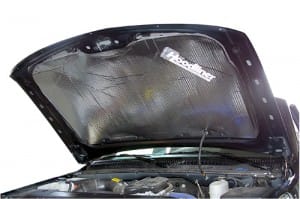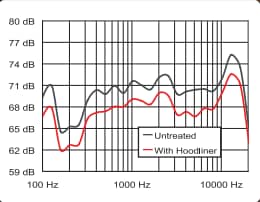Table of Contents
Dynamat Hoodliner Review: Protecting Your Vehicle’s Performance
Your engine isn’t just the heart of your car; it’s also a massive heat generator. This heat, if not properly managed, can wreak havoc on your vehicle’s paint job and interior comfort. Here’s where the Dynamat Hoodliner steps in as a knight in shining armor. Designed with the sole purpose of defending your car from the adverse effects of engine heat, it serves as a critical layer of protection.
Stopping Heat in Its Tracks

The Dynamat Hoodliner is not just any sound deadener; it’s a specialized tool tailored for the hood to prevent heat damage to your car’s paint. It excels in lowering engine sound and vibrations, creating a quieter, more peaceful driving experience. This review dives deep into how the Hoodliner muffles high engine noises and stands strong as a fire-retardant and heat-resistant shield. Whether it’s the ease of installation or the wide-ranging benefits, this product has a lot to offer.
A DIYer’s Dream
As a DIY enthusiast, I appreciate products that simplify the complex, and the Dynamat Hoodliner is a perfect example. It’s easy to install, making it ideal for anyone looking to enhance their vehicle’s performance without professional help. This Hoodliner is your go-to solution for a cooler, quieter ride, transforming your car into a serene oasis amidst the chaos of road noise and engine heat.
Sound Management with Dynamat Hoodliner
When tackling the din of engine noise, Dynamat Hoodliner shines as your go-to solution. Its prowess in silencing engine noise is unmatched, whether that racket is barging in through the dashboard’s firewall, sneaking beneath your feet, or infiltrating through the doors. The Hoodliner acts as a guardian, not just safeguarding your hood’s paint from the scorching heat but also dialing down those pesky noises.
For those pondering “What’s the best sound-deadening material?“, let’s clear the air. Dynamat Hoodliner stands out for its dual assault on heat and sound.
Dynamat Hoodliner’s efficiency in cutting through noise across the spectrum is a testament to its design and functionality. It’s not just about reducing noise; it’s about enhancing your ride’s comfort and performance. So, for those in search of the best quality sound insulation, your quest might very well end with Dynamat.
Thermal Insulation Mastery with Dynamat Hoodliner

The Dynamat Hoodliner is your car’s shield against the scorching heat. Its aluminized skin isn’t just tough; it’s smart. Easy to clean, resistant to oil and water, and a champion in reflecting 97% of radiant heat, this hoodliner ensures your vehicle’s paint remains unscathed from engine’s fury. With its 1 mil. reinforced aluminized skin, it acts as a formidable barrier against heat, reflecting back a staggering 97% of radiant heat.
Dynamat claims the Hoodliner can stand guard up to 300 F, though the official heat tolerance is 220 F. This distinction highlights its robustness in protecting against high temperatures. For those inquiring, “Does Dynamat reduce heat?” Absolutely, it does. Dynamat’s Hoodliner is specifically engineered to tackle heat head-on, setting a benchmark in thermal insulation.
The Hoodliner’s efficiency in keeping your engine’s heat at bay while preserving your car’s aesthetics is unparalleled. It’s a testament to Dynamat’s commitment to not just soundproofing but also ensuring your ride remains cool under pressure.
Versatility of Dynamat Hoodliner

The Dynamat Hoodliner isn’t just about reflecting heat; it’s a versatile powerhouse designed for a range of applications beyond the hood. Ideal for noise control and thermal insulation, it finds its place in truck and automotive hoods, engine compartments, as well as in generator housings and motor homes. Its effectiveness isn’t limited to vehicles alone; outboard motors and diesel engines also benefit from its protective embrace.
This multi-purpose product stands out when considering the best sound deadening material. It’s crucial to recognize the Hoodliner’s broader applications. Hoodliner extends its utility to thermal insulation, showcasing its superiority in versatility.
For those seeking the best quality sound insulation, the Dynamat Hoodliner provides an answer, ensuring your projects aren’t just limited to soundproofing but are also safeguarded against heat. Its multi-purpose nature assures that whether you’re tackling dynamat heat insulation or exploring sound deadening alternatives, the Hoodliner’s capabilities make it a go-to solution for a myriad of needs.
Hoodliner is a peel-and-stick product making the installation relatively straightforward.
| Feature | Dynamat Hoodliner | Kilmat |
|---|---|---|
| Sound Reduction | Excellent in reducing engine noise and vibrations | Good, effective at damping sound |
| Heat Insulation | Reflects up to 97% of radiant heat; protects up to 220 F | Varies, generally lower heat resistance |
| Ease of Installation | Self-adhesive, easy to cut and apply to curved surfaces | Self-adhesive, easy to cut and apply |
| Cost | Higher upfront cost, but offers high value for performance | More affordable, good for budget-conscious consumers |
| Versatility | Ideal for automotive hoods, engine compartments, etc. | Suitable for a variety of surfaces, including vehicle interiors |
| Additional Features | Multi-purpose with a focus on heat and sound insulation | Primarily focuses on sound deadening |
You should check your car’s manual first. For around $20, you can find a detailed version. The easiest way to find the hard copy repair manual for your vehicle is to select Repair Manuals by Make and Model. Or you can get an electronic version. They both have all sorts of instructions and guides, whether it’s for customization, maintenance, repair, or even simply just learning about the inner workings of a particular vehicle.
Easy Installation Tips for Dynamat Hoodliner
Installing the Dynamat Hoodliner can be a breeze with the right approach. Here’s a simplified guide to ensure you get it right:
- Preparation is Key: Start by removing the hood and laying it out flat. This makes it easier to work with and ensures a precise fit. Trace the outline of the hood on the peel-off side of the Hoodliner for an exact match.
- Cut to Size: With a steady hand, cut the Hoodliner using a razor knife or scissors. Accuracy here will save you time and ensure a clean look.
- Position and Stick: Place the cut piece on the engine block, mimicking the hood’s closed position. This method helps align the Hoodliner perfectly. Peel off the backing, and gently close the hood, pressing the Hoodliner into place.
- Finishing Touches: After re-opening the hood, press down the liner with a roller to secure it firmly across the hood’s interior. For added durability and a polished look, edge finishing with aluminized tape is recommended but not mandatory.
- Temperature Matters: Keep in mind, that installation below 45°F might hinder the adhesive’s effectiveness. Ensure you’re working in an adequately warm environment.
- Layer for Extra Protection: While the Hoodliner works great on its own, layering it atop Dynamat Xtreme can further enhance its noise and heat insulation capabilities. This step, however, is optional based on your specific needs.
- Application: Apply the Hoodliner to the hood’s flat surfaces, avoiding the ribs for a smooth application. Thanks to its pliability, fitting it around curves and contours is straightforward.
By following these steps, installing the Dynamat Hoodliner becomes an easy task that significantly boosts your vehicle’s performance by reducing noise and heat. It’s an investment in your vehicle’s longevity and your comfort as a driver.
Regarding the “People also ask” questions:
- Can you use Dynamat under the hood? Yes, it’s designed for this purpose, offering both heat insulation and sound damping.
- Is Dynamat good for heat? Absolutely, it’s effective at reflecting and insulating against engine heat.
- Does Dynamat reduce exhaust noise? While primarily aimed at engine noise, it can also help dampen exhaust noise as part of an overall soundproofing strategy.
- Can you put Dynamat in the engine bay? Yes, it can be used in the engine bay to reduce noise and protect against heat.
This method not only simplifies the installation process but also maximizes the benefits of Dynamat Hoodliner, ensuring your ride is quieter and cooler.
National Consumer Center offers you a chance to get a $500 gift card to Amazon. The payouts are quick, and you can use the Gift Card to pay for some of your Amazon products.
Conclusion
In conclusion, the Dynamat Hoodliner offers an impressive 12 ft² of high-quality material designed to enhance your vehicle’s performance by providing superior thermal insulation and noise reduction. Its silver surface not only adds a visual appeal to your engine compartment but also makes it easier to navigate and work within the space. The self-adhesive nature of the Hoodliner allows for a straightforward installation on curved surfaces, making it accessible for DIY enthusiasts of all levels.
This product stands out for its multi-purpose functionality, effectively tackling both heat and sound issues. Whether you’re looking to reduce engine noise or protect your car from excessive heat, the Dynamat Hoodliner proves to be a robust solution. It’s an affordable upgrade that can significantly improve your driving experience.
If you’re ready to take the next step in enhancing your vehicle’s performance, don’t hesitate. Dive into the world of Dynamat products and discover how the Hoodliner can transform your ride. For detailed buying information and installation guidelines, be sure to check out the additional resources provided. Elevate your vehicle’s performance today with Dynamat Hoodliner. For more insights and detailed guides on using Dynamat products across various applications, explore our other posts. Your journey to a quieter, cooler ride begins now.
What to do next
I’ve detailed the application process for sound-deadening materials. If you’ve already decided on where you want to apply it see my comprehensive guidelines for
If you’re not sure where to start, I strongly recommend you begin with the doors. From there, you can move on to the trunk.
What you’ll need

A panel removal tool kit is required for the panel pins. This is because they avoid breakage of the pins during the removal of them. It’s also useful for prying away the panels without doing damage to your vehicle’s paint job.

Aluminum tape is also needed. You can patch up the parts where there might be gaps left or use the tape to give your application a clean finish.

Wear a good pair of workman’s gloves while working with the material. The foil edges are sharp and cut through your skin. The glue is also best avoided.

You can use metal shears instead of scissors for products like Dynamat and others. You can also use a switchblade.

Use the correct seam sealer (if required) to avoid it setting and causing ripples on your trunk lid. In addition, the seam sealer should maintain some flex when dries.
You may want to get a set of additional Bumper Retainer Clips, just in case you damage some or if you find a few missing already.

Use a portable light system to make it easier for you to see.
On these other blogs, I’ve provided a guide to purchasing the right pack size for whatever project you plan on undertaking. The step-by-step guide walks you through the process, including application.
You should check your car’s manual first. For around $20, you can find a detailed version. The easiest way to find the hard copy repair manual for your vehicle is to select Repair Manuals by Make and Model. Or you can get an electronic version. They both have all sorts of instructions and guides, whether it’s for customization, maintenance, repair, or even simply just learning about the inner workings of a particular vehicle.
Good luck and happy soundproofing!
Dynamat.com | Dynamat Xtreme for Automotive and Restoration Use. (2024). Retrieved from http://www.dynamat.com/automotive-and-transportation/automotive-restoration/dynamat-xtreme/
